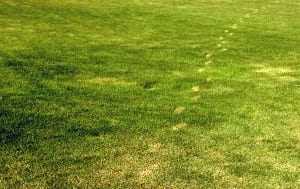 As the fall season gives way to winter conditions in southern Utah and the desert southwest, it is not uncommon for winter golfers to experience frost delays. Golf courses will declare frost delays to protect the course from certain turf damage done by players both walking and driving their carts while they are venturing out to the fairways, tee boxes, and greens.
As the fall season gives way to winter conditions in southern Utah and the desert southwest, it is not uncommon for winter golfers to experience frost delays. Golf courses will declare frost delays to protect the course from certain turf damage done by players both walking and driving their carts while they are venturing out to the fairways, tee boxes, and greens.
It is critical to remember, though, that just because there is frost doesn’t mean it’s necessarily uncomfortable to play in. Since it’s sunny almost 330 days a year in this region, the desert does warm up quickly by mid-morning.
 Frost can do critical damage to a golf course, which is important for golfers to understand. During my first job as a teenager at West Bend Country Club in Wisconsin, my job consisted of setting out practice balls for members to hit in the morning. Unknowingly to my immature considerations, I walked one frosty morning in September onto the range and was almost fired that morning by laying down about 60 footprints on white frosted grass. Luckily, I kept my position long enough to see that the footprints never disappeared until the snow fell that winter. Obviously I learned my lesson, but it is important to understand what frost is.
Frost can do critical damage to a golf course, which is important for golfers to understand. During my first job as a teenager at West Bend Country Club in Wisconsin, my job consisted of setting out practice balls for members to hit in the morning. Unknowingly to my immature considerations, I walked one frosty morning in September onto the range and was almost fired that morning by laying down about 60 footprints on white frosted grass. Luckily, I kept my position long enough to see that the footprints never disappeared until the snow fell that winter. Obviously I learned my lesson, but it is important to understand what frost is.
According to USGA’s Charles White:
“Frost on the grass blades tells us that the water inside the leaves is frozen. Remember that water is the primary component of plant tissue. When this water is frozen, traffic on the turf causes the ice crystals in the cells to puncture through the cell walls, killing the plant tissue. Little damage is done to the crowns (growing points) or roots if only a light frost appears; however, when the frost is heavy, cell disruption may occur at the crown, thus killing the entire plant. Frost damage symptoms include white to light tan leaves where traffic has passed.”
Frost delays are an annoyance, not only for golfers but also for the turf grass management team or grounds crew. If the grounds crew is typically preparing the course an hour ahead of the first tee-time by mowing, setting new pin placements, address daily details critical to the aesthetics of the golf course, etc., the entire process gets suffocated for time to accommodate golfers’ getting out to play. The critical point is that golfers may not see frost on their patio view of the golf course or even when they arrive to the driving range, but the consideration golfers need to understand is there are trees, canyons, and other flora that inhibits sunlight to turf that isn’t necessarily on the first hole. Frost patterns will vary throughout the entire property of the golf course.
The best part about playing golf is to be able to play on great turf conditions that can handle the pressure of foot, golf cart, and mower traffic because of its elasticity. When frost hits, the elasticity of the blades of grass is vulnerable because they will not bend and give way to the pressure of any traffic. They will simply snap off. The consequential part of a broken blade of grass is that during the winter, grass doesn’t grow at all. So to have damaged grass by allowing players to drive their carts everywhere and walk before the frost lifts simply means the golf course will have a lot of dirt spots on their course by springtime.
As a fellow golfer, I am very lucky and privileged to play golf all year in such a scenic environment. It is important that we do not ignore considerations such as frost delays and cart path restrictions when playing during the winter season.



